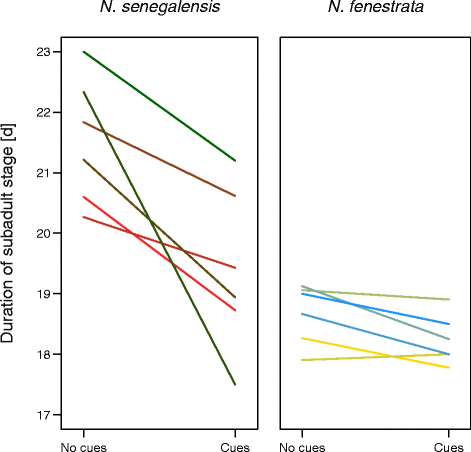Socially cued developmental plasticity in web-building spiders
- PMID: 27561330
- PMCID: PMC5000426
- DOI: 10.1186/s12862-016-0736-7
Socially cued developmental plasticity in web-building spiders
Abstract
Background: Socially cued anticipatory plasticity (SCAP) has been proposed as a widespread mechanism of adaptive life-history shifts in semelparous species with extreme male mating investment. Such mating systems evolved several times independently in spiders and male reproductive success should critically depend on timely maturation and rapid location of a receptive and, ideally, virgin female. We experimentally investigated socially cued anticipatory plasticity in two sympatric, closely related Nephila species that share many components of their mating systems, but differ in the degree to which male reproductive success depends on mating with virgin females. Juveniles of both species were reared either in the presence or absence of virgin female silk cues. We predicted strong selection on socially cued plasticity in N. fenestrata in which males follow a highly specialized terminal investment strategy, but expected a weaker plastic response in N. senegalensis in which males lost the ability to monopolize females.
Results: Contrary to our predictions, N. fenestrata males presented with virgin female silk cues did not mature earlier than siblings reared isolated from such cues. Males in N. senegalensis, however, showed a significant response to female cues and matured several days earlier than control males. Plastic adjustment of maturation had no effect on male size.
Conclusions: Our results indicate that a strong benefit of mating with virgins due to first male sperm priority does not necessarily promote socially cued anticipatory plasticity. We emphasize the bidirectional mode of developmental responses and suggest that this form of plasticity may not only yield benefits through accelerated maturation, but also by avoiding costs of precipitate maturation in the absence of female cues.
Keywords: Adaptive plasticity; Density cues; Environmental uncertainty; Information use; Male-male competition; Nephilidae; SSD.
Figures
Similar articles
-
A comparative analysis of the morphology and evolution of permanent sperm depletion in spiders.PLoS One. 2011 Jan 11;6(1):e16014. doi: 10.1371/journal.pone.0016014. PLoS One. 2011. PMID: 21264312 Free PMC article.
-
Can You Trust Who You See? The Evolution of Socially Cued Anticipatory Plasticity.Am Nat. 2021 Apr;197(4):E129-E142. doi: 10.1086/712919. Epub 2021 Feb 11. Am Nat. 2021. PMID: 33755539
-
The eunuch phenomenon: adaptive evolution of genital emasculation in sexually dimorphic spiders.Biol Rev Camb Philos Soc. 2015 Feb;90(1):279-96. doi: 10.1111/brv.12109. Epub 2014 May 8. Biol Rev Camb Philos Soc. 2015. PMID: 24809822
-
Sexual selection and sperm quantity: meta-analyses of strategic ejaculation.Biol Rev Camb Philos Soc. 2011 Nov;86(4):863-84. doi: 10.1111/j.1469-185X.2011.00175.x. Epub 2011 Mar 17. Biol Rev Camb Philos Soc. 2011. PMID: 21414127 Review.
-
Spider sex pheromones: emission, reception, structures, and functions.Biol Rev Camb Philos Soc. 2007 Feb;82(1):27-48. doi: 10.1111/j.1469-185X.2006.00002.x. Biol Rev Camb Philos Soc. 2007. PMID: 17313523 Review.
Cited by
-
Effects of social information on life history and mating tactics of males in the orb-web spider Argiope bruennichi.Ecol Evol. 2017 Nov 28;8(1):344-355. doi: 10.1002/ece3.3672. eCollection 2018 Jan. Ecol Evol. 2017. PMID: 29321876 Free PMC article.
-
Mate availability does not influence mating strategies in males of the sexually cannibalistic spider Argiope bruennichi.PeerJ. 2018 Aug 7;6:e5360. doi: 10.7717/peerj.5360. eCollection 2018. PeerJ. 2018. PMID: 30123703 Free PMC article.
-
Risky business: males choose more receptive adults over safer subadults in a cannibalistic spider.Behav Ecol. 2022 Apr 25;33(4):688-697. doi: 10.1093/beheco/arac023. eCollection 2022 Jul-Aug. Behav Ecol. 2022. PMID: 35812367 Free PMC article.
-
Widow spiders alter web architecture and attractiveness in response to same-sex competition for prey and mates, and predation risk.Commun Biol. 2023 Oct 11;6(1):1028. doi: 10.1038/s42003-023-05392-y. Commun Biol. 2023. PMID: 37821674 Free PMC article.
-
Fitness implications of sex-specific catch-up growth in Nephila senegalensis, a spider with extreme reversed SSD.PeerJ. 2017 Nov 15;5:e4050. doi: 10.7717/peerj.4050. eCollection 2017. PeerJ. 2017. PMID: 29158981 Free PMC article.
References
-
- Smith-Gill SJ. Developmental plasticity: developmental conversion versus phenotypic modulation. Am Zool. 1983;23(1):47–55. doi: 10.1093/icb/23.1.47. - DOI
-
- Pigliucci M. Phenotypic plasticity. In: Müller G, Pigliucci M, editors. Evolution: The Extended Synthesis. Cambridge: MIT Press; 2009. pp. 355–378.
-
- Bradshaw AD. Evolutionary significance of phenotypic plasticity in plants. Adv Genet. 1965;13(1):115–155.
-
- Stearns SC. The role of develoment in the evolution of life histories. Life Sciences Research Report. 1982. p. 237–58.
MeSH terms
Associated data
LinkOut - more resources
Full Text Sources
Other Literature Sources


